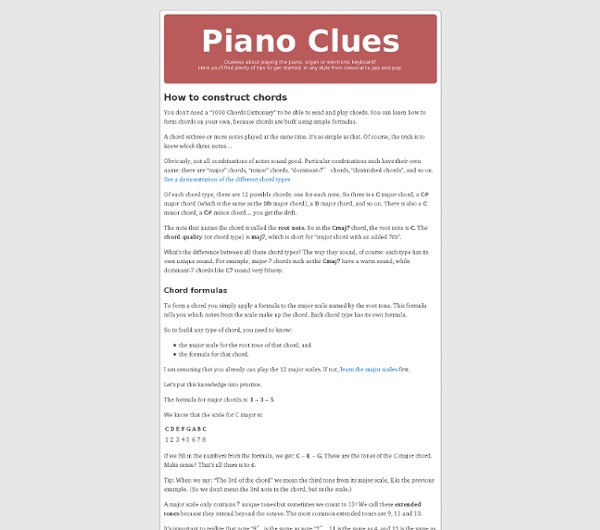Learning and Loving Music Theory
Kelvin, You actually caught a mistake on the roman numerals! Thanks, I’ll have to fix that. The first and last chords of the progression are not 7th chords. Somehow I inadvertently typed “I7″ on the first chord of all the major keys. (Notice that I didn’t do that for the minor keys.)
Scales and emotions
See also a post about making chords from scales. So maybe you want to write a song or an instrumental in a particular mood or style, and you’re feeling overwhelmed by all the scales. Here’s a handy guide to the commonly used scales in Western pop, rock, jazz, blues and so on. Click each image to play the scale right in your browser with the aQWERTYon.
33 Ways to Make More Time in Your Life For Music-Making
1. Disconnect. Power down your computer–or if you absolutely need the thing for some reason related to your practice and studies, sever it from the internet by disabling wireless. 2.
Harmony Explained: Progress Towards A Scientific Theory of Music
The Major Scale, The Standard Chord Dictionary, and The Difference of Feeling Between The Major and Minor Triads Explained from the First Principles of Physics and Computation; The Theory of Helmholtz Shown To Be Incomplete and The Theory of Terhardt and Some Others Considered Daniel Shawcross Wilkerson Begun 23 September 2006; this version 19 February 2012. Abstract and Introduction
Best Quotes of All Time
It’s been three years since we shared our original list of some of the best quotes of all time, and we felt it was a good time for an update. We’ve added another 25 quotes for you. But these aren’t just any quotes. These are quotes designed to inspire.
Free Music Theory Worksheets!
Material on this page is free.NEW! you can now consult an index of terms used in these worksheets.Also explore a page of worksheet extras: Worksheet Answers, Test Templates and Flash Presentations. Here are some testimonials from music teachers about these workbook chapters: I have been using your fantastic music theory sheets and PDF downloads to teach high school piano theory to 28 students per class, all of whom are at different levels of study and accomplishment. Your method is comprehensive and easily accessible to students of all ages. What a great philanthropist and talented musician you are and it is indeed a pleasure to have discovered that I can thank you (in person) on Facebook ...
Outline of basic music theory
Professional music theory: an outline of basic music theory. Preface and Chapter 1 of the Outline of basic music theory – by Oscar van Dillen ©2011-2014 The beginner’s learning book can be found at Basic elements of music theory. Overview of chapters: Chapter 1: Introduction Chapter 2: Sound and hearing Chapter 3: Musical notation Chapter 4: Basic building blocks of melody and harmony Chapter 5: Consonance and dissonance Chapter 6: Circle of fifths and transposition Chapter 7: Concerning rhythm, melody, harmony and form Chapter 8: Further study Preface
Products : Overview : Music Software
How Music Works is a comprehensive suite of multimedia tutorials which explain music in clear, simple language you can relate to. Packed with 115 topics in nine tutorials, and illustrated with 360 diagrams and 750 demonstration sounds, the tutorials start with the very basics of music and advance to topics which are valuable even for professional musicians. Whatever musical instrument or style you are interested in, these tutorials will be an essential source of information and guidance for years to come.
The Cube Game - Find Out The True Nature Of People
In this video I am going to play with you The Cube game. This psychological game is from the book “Secrets of the Cube” .
10 Essentials On Guitar Improvisation
Photo by Simone13 AKA John Pastorello Besides writing and playing songs I just love improvising. When I practice improvising I always first pour myself a cup of green tea, I put on some folk music (e.g. Ray La Montagne, Damien Rice, Stephen Fretwell, Glen Hansard, Sheryl Crow, etc.) on Last.fm or Spotify.com and then I start to improvise over these songs.



